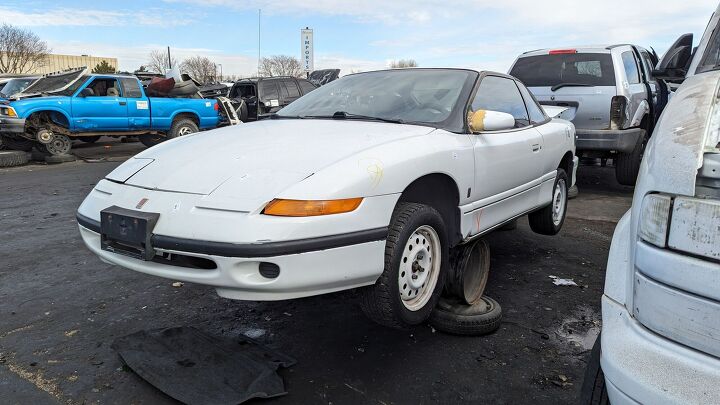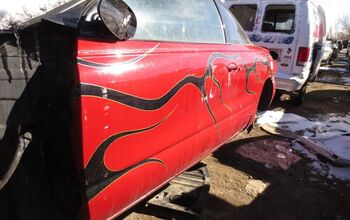Junkyard Find: 1996 Saturn SC2

The Saturn Division spent the first half of the 1990s printing money for The General with its no-haggle pricing policy and plastic-bodied cars that only rusted in areas you couldn't see easily, and all those cars were based on a single platform: the S Series. Today's Junkyard Find is an example of the sporty coupe version of the first-generation Saturn S, found in a Denver-area boneyard recently.
The sedan and wagon versions of the S Series, the SL and SW, had been facelifted for the 1996 model year, but the first-generation SC with its pop-up headlights and smooth sides held on for one last year.
As we all know, the 2000s didn't work out so well for Saturn, with the aging S Series replaced by the Opel Vectra-derived L Series and then by a bunch of machinery few were able to distinguish from other GM products. After 2010, Saturn was dead, its demise overshadowed by Pontiac's death and its legacy not even as strong as Geo's.
But we're not here to mourn Saturn. We're here to praise this SC2 for staying on the road for close to three decades and well over 250,000 miles.
This being a top-trim-level SC2, it has a twin-cam engine and a nicer interior than the SC1.
The defective hood-latch mechanism prevented me from shooting engine photos, a common problem on GM cars of this era, but we can assume that the original 1.9-liter DOHC engine and its 124 horsepower/122 pound-foot engine was still there. The transmission is the base five-speed manual; the optional automatic added $830 to the price (about $1,658 in 2024 dollars).
The (no-haggle) MSRP for this car was $13,295, or about $25,557 after inflation. That year, American car shoppers could buy a new 1996 Honda Civic DX coupe with five-speed manual for just $11,720 ($23,411 now), but that car had a mere 98 horsepower.
The Civic's Integra sibling had three more horses than the SC2, but its price tag started at a daunting $15,460 ($30,882 today).
Of course, the '96 Integra came with air conditioning and power windows as standard equipment. This car has neither. The $14,200 ($26,365 now) Chevy Cavalier Z24 coupe and its 150hp Quad 4 probably stole more sales from the SC2 than any Honda product ever did, anyway.
When the left-side mirror got broken off, this car's owner fixed it with fiberglass.
The drawback to the plastic body panels was their tendency to break, especially after a decade or two of service.
Oldsmobile was gone after 2004, not long after Geo had to endure having its final two models torn away and handed to Chevrolet in 1997 and 1998. Pontiac production continued a bit longer than Saturn production, but both were dead and buried by the end of 2010. At least they outlived Isuzu by a bit here, though Saab held on for a bit longer. And, hey, Opel and Vauxhall remained in the GM Empire until fairly recently.
You couldn't even find used Saturns in 1996, because nobody wanted to sell them (some suspension of disbelief required, though the Cult of Saturn was still in effect at that time).
Jet pilots prefer the SC2 flight simulator.
1996 Saturn SC2 in Colorado wrecking yard.
1996 Saturn SC2 in Colorado wrecking yard.
1996 Saturn SC2 in Colorado wrecking yard.
1996 Saturn SC2 in Colorado wrecking yard.
1996 Saturn SC2 in Colorado wrecking yard.
1996 Saturn SC2 in Colorado wrecking yard.
1996 Saturn SC2 in Colorado wrecking yard.
1996 Saturn SC2 in Colorado wrecking yard.
1996 Saturn SC2 in Colorado wrecking yard.
1996 Saturn SC2 in Colorado wrecking yard.
[Images: The author]
Become a TTAC insider. Get the latest news, features, TTAC takes, and everything else that gets to the truth about cars first by subscribing to our newsletter.

Murilee Martin is the pen name of Phil Greden, a writer who has lived in Minnesota, California, Georgia and (now) Colorado. He has toiled at copywriting, technical writing, junkmail writing, fiction writing and now automotive writing. He has owned many terrible vehicles and some good ones. He spends a great deal of time in self-service junkyards. These days, he writes for publications including Autoweek, Autoblog, Hagerty, The Truth About Cars and Capital One.
More by Murilee Martin
Latest Car Reviews
Read moreLatest Product Reviews
Read moreRecent Comments
- Yuda Yeah with all the friggin problems these things have, last thing we need is more of these things messing up and clogging the roads
- Wjtinfwb Nice car and looks well cared for. The accessories are mostly for vanity, their value is in the eye of the buyer. I see zero value in them but I like bone stock if buying used. The problem this seller has is his spec is not at all unique; not a manual, no Shaker hood, attractive, but conservative color. Today, AutoTrader has 130 used 2015-2018 Challenger Hemi's with automatics available. The average price is abut 27,200 and mileage is slightly lower than this example at about 40k miles. Almost all are at dealers where a decent negotiator should be able to knock $1500-2500 off the ask. This is a 25k car, the buyer may not believe it but stats would say otherwise.
- FreedMike I don't need to know anything about this model per se, but I'd be very interested in knowing if Mazda is going to be using the tech from the PHEV CX-90/70 model - which is darned nice, by the way - on other Mazdas.
- Turbo Is Black Magic Honestly at this point Elon is more of a liability than an asset. How much does the board have to pay to just get rid of him?
- FreedMike The article touches on this fact, but the number of public EV chargers grew by over 18,000 between 2021 and 2023. https://afdc.energy.gov/fuels/electricity-infrastructure-trendsSo clearly the expansion is happening without the use of the funds in question. Not necessarily a bad thing, if you're into not using taxpayer money. Still, I'd be interested in knowing why the public money isn't being used. Are the regs overly complex or restrictive, or something like that? But in any case, EV charging IS expanding at a pretty solid rate. And as far as "...we’ve seen plenty of Republican-backed legislation targeting EV-related spending over the last couple of years" is concerned...well, yeah, there's a reason why Republicans don't like EV charging. The petroleum industry is one of the GOP's prime donors, and every charger built or EV sold represents a direct ding to their bottom line. Republicans, of course, like to put this in terms of "EVs are a woke mind virus," or some such nonsense, but the fact is that the people paying their bills don't want competition.





















































Comments
Join the conversation
I never owned an S-Series but I can recall my previous 2003 Saturn Vue with the Ecotec and 5spd manual had pretty much the same instrument cluster and steering wheel with a few touch ups here and there like the switch from analog to digital odometer
The Saturn L-series did not replace the S-series. The L was a larger car, for Saturn customers who outgrew their S-series. The S-series was replaced eventually by the Saturn Ion.